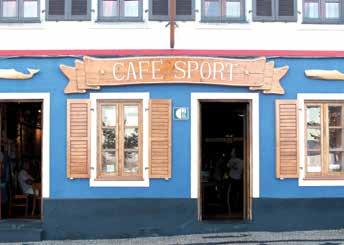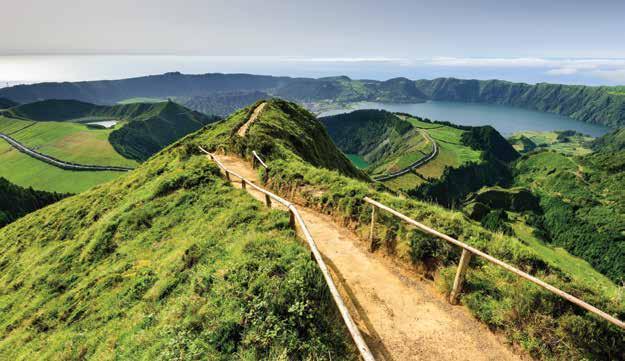
6 minute read
The Azores: An adventure through the freshest islands in the Atlantic
from Bon Vivant Fall 2019
by Ensemble
THE AZORES:
An adventure through the freshest islands in the Atlantic
BY TIM JOHNSON
ASTRING OF VOLCANIC ISLANDS sitting in the middle of the Atlantic, this archipelago – pounded by waves, girded by forbidding cliffs, all of it often shrouded in mist – was long a critical way station for explorers seeking the New World, including, most famously, Christopher Columbus, who stopped by a couple of times.
But those who settled here, who came here for the long haul to build a life, mostly fell into two categories: farmers, and fishermen. And today? I’m the latter.

Rolling out from Angra do Heroismo on the Big White, the clouds above darkening by the minute, the winds blustering to a stiff 15 knots, I ready my line, hoping for a big catch.
Reaching the northwest corner of the tiny island of Terceira, a place exposed to the elements and known for rough weather, I brace myself against the white hull of the boat, casting out into rocky waters, under a watery sun. Given my past experience with a rod and reel, I’m not hopeful, having had little joy (or luck) in the past.
But – the Big White now steadily rocking, my guide, Paolo, calling instructions from the confines of the wheelhouse – the fish hits my line as suddenly as a bolt of lightning. And soon, having fought him, reeling hard, he’s flashing in the bottom of the boat, ferocious and beautiful, white teeth gnashing, looking like a cross between a lake trout and a shark.
Paolo pats me on the back, telling me I’ve caught a bonito – a true sport fish. Within the next half hour, I’ll hook into two more fighters, these ones both pink grouper. Reeling up and heading back to port, leaving the growing storm behind us, my stomach rumbles knowing that I will soon have something similar, steaming, with a side of vegetables, on my plate.
I’m island-hopping in the Azores, a growing tourism destination with direct flights from Canada. Technically part of Portugal, these nine islands are a place apart, each one with its own individual personality and, collectively, an autonomous spirit.

With waters swimming with abundant sea life, super-productive, mineral-rich fields and vineyards flourishing in the volcanic soil, they have everything you need for a delicious vacation – namely, fresh fish, meat, greens and, perhaps most importantly, an ocean of good wine.
I begin on Terceira, a round, 400-square-kilometre island with about 55,000 residents and a long history. The winding lanes, bell towers and cobblestone squares of Angra do Heroismo form the oldest city on the Azores and a UNESCO World Heritage Site. Based here, Paolo drives me around the island.
We hike into an empty volcano and walk through the verdant countryside – once, past an angry bull. And we stop at wine tastings and cheese museums, and through the black rock formations and natural swimming pools along the coastal lava field at Biscoitos – itself named after a popular old-time snack for sailors.

The lighthouse Farol do Arnel near Nordeste
And, along the way, we enjoy many very good meals – tuna steaks, cooked just right, and grilled grouper, flaky and perfect, and even hamburgers made from some of the best beef I’ve ever tasted, using beef dry-aged, like a fine cut of sirloin, for more than two weeks.
We spend part of an afternoon at the Quinta do Martelo, where owner Gilberto Viera takes us on a rambling tour of a farm that reconstructs five centuries of life here, recreating a time when agricultural enterprises formed the heart and soul of these islands.
In the past, these farms were almost whole villages, and the Martelo relives those days and includes stone homes, which now host guests in a sort of period-specific boutique hotel, as well as shops, a restaurant and a mill.

Pico island vineyards
“Right here, they grew, and made everything we need for our lives,” Viera tells us. “Nowadays, they call it organic and local. But we call it traditional. Because if it’s fish, it’s fish, and if it’s meat, it’s meat.”
We sample a little of everything grown on site – fava beans, olives, goat cheese with a red pepper sauce and wash it down with red wine. Then, soon after, we dig into a hearty lunch of alcatra, beef rump slow-cooked and served up in a clay pot, a meal that was once reserved for special occasions, like the Festival of the Holy Ghost.
From Terceira, I make my way to the neighbouring islands of Pico and Faial. These two, within sight of one another, form an uneasy pair, the former traditionally home to workers, the latter to (rich) landowners. Within minutes, I’m told the favourite local joke-that’s-not-a-joke for the first (of many) times: “On Pico, we love rainy, foggy days – because you can’t see Faial.”

Peter’s Café Sport in Horta
The message: the workers here don’t like their closest neighbour or its wealthy residents. But, other than the namesake volcano – a massive, green cone that dominates almost every vista here – Pico has another, major claim to fame: a strange and wonderful wine culture.
Some four-fifths of all the wine produced on the Azores is grown here, and, for centuries, it’s been exported across Europe, as far as the royal court of the tsars in Russia (I’m told there’s even a reference to it in Leo Tolstoy’s War and Peace). Planted first in the 15th century, almost a thousand hectares have now been preserved as a UNESCO World Heritage Site.
Led by another local guide, Rai, we walk among a complex network of tiny plots (called currais) surrounded by 1.5-metre volcanic stone walls, which reflect the heat of the sun onto the vines within, and protect them from winds off the mountain and ocean.
There’s not much sun today, and a mist hangs over the water – and Rai notes that it’s a good day because– well, you know. She also shows me a series of adegas near the coast, small stone villas passed down through generations of families, where they still gather to eat and drink on fair-weather days.

A cow resting in a lake near mount Pico
Nearby, we see the tracks of oxcarts, worn into the stone over hundreds of years, carrying barrels for export. “We have a saying here, ‘Life on Pico is harder than a rock,’” Rai says. “From here, the wine went to rowboats, to Faial, to the rest of the world.”
Before heading to Faial, I have a tasting with a local winemaker, Fortunato Duarte Garcia. He tells me that three things make the vintages here special – the acidity of the mineral-rich soil, the proximity of the sea, and the rare varietals, including Arinto dos Acores and Terrantez do Pico.
We make our way through a series of bottles without labels, all made from his small vineyard, just 3.5 acres. And then he favours me with a small taste of his best, Czar Vinho Licoroso (one vintage retails for more than $1,300 CAD per bottle). It’s rich, a late-harvest wine and provides good fuel for my short trip to Faial.

Lakes of Sete Cidades
I cross the narrow channel between the two islands where, as it turns out, nobody has heard Pico’s favourite joke. Many adventures await here: Visiting the site of one of the 20th century’s most famous volcanic eruptions, Capelinhos, which boiled for more than a year in the 1950s, lava increasing the island’s size by more than two square kilometres, with thousands displaced (many, to Canada).
Also, massive blue whales, which I will see tomorrow, just a few metres from the side of a zodiac. And, Horta Marina, with its hundreds of yachts, this, perhaps the most important layover for modern-day explorers, making their way across the Atlantic in both directions.
But first, I will eat. Finding a pub called Peter Café Sport right near the marina, I join some of those sailors who have made this place something of a legend, spreading word of its fresh seafood by word-of-mouth across the ocean. I settle in, tucking into a tuna steak, fortifying and readying myself for the rest of Faial with more islands just on the horizon.








